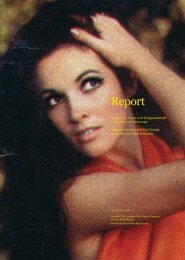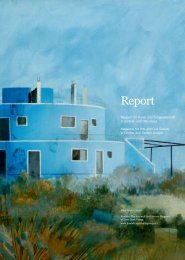Report_Issue 1/2009 - Jubiläum/ 20 Jahre Mauerfall
Report_Issue 1/2009 - Jubiläum/ 20 Jahre Mauerfall
Report_Issue 1/2009 - Jubiläum/ 20 Jahre Mauerfall
Sie wollen auch ein ePaper? Erhöhen Sie die Reichweite Ihrer Titel.
YUMPU macht aus Druck-PDFs automatisch weboptimierte ePaper, die Google liebt.
How have the culture scenes in the former East Bloc and in the countries that once made up Yugoslavia developed<br />
since 1989? Do the categories “East” and “West” retain any meaning in art? A summary by Eastern Europe experts<br />
Margarethe Makovec and Anton Lederer from the Graz art association , one of the hubs for art from Eastern<br />
and Southeastern Europe and Austria.<br />
— Herwig G. Höller talks with Margarethe Makovec and Anton Lederer —<br />
Is there just a single story to be told about eastern<br />
and southeastern European art in the last<br />
twenty years?<br />
Margarethe Makovec: The developments in art<br />
in the last twenty years, for example in Romania,<br />
former Yugoslavia and the Czech Republic,<br />
cannot be compared with each other, even<br />
though the socio-political themes that artists<br />
from these countries deal with are similar.<br />
What these countries have in common is that<br />
their art scenes were strongly influenced by<br />
the involvement of the American investment<br />
banker and patron George Soros. In each of<br />
the capital cities Soros helped set up a centre<br />
for contemporary art that was headed by a local<br />
person. From that point onwards there was,<br />
finally, a local communication and information<br />
platform for contemporary art and there was<br />
money for the production of art.<br />
But is it not true that Soros’ involvement is no<br />
longer viewed quite so uncritically?<br />
Anton Lederer: In principle Soros’ involvement<br />
was a wonderful thing. In the mid-1990s he<br />
invested money in art – at a time when there<br />
was no structure of support in most of these<br />
countries. This set things moving within the<br />
art scenes, and a sizable number of catalogues<br />
were published. Ten years after the fall of the<br />
Iron Curtain when the important exhibition<br />
“After the Wall” was shown in the Moderna<br />
Museet in Stockholm and was followed by a<br />
certain hype about these countries, foreign<br />
curators were able to orient themselves with<br />
the aid of these centres and publications. The<br />
disadvantage of Soros’ culture centres was<br />
that they created peaks that were in complete<br />
contrast to the cultural landscape surrounding<br />
them. The example of Lejla Hodžić in Sarajevo<br />
always shocked me: as a young staff member of<br />
the Soros Centre in the capital she earned more<br />
than her father, an eminent surgeon.<br />
M. M.: And the fundamental idea that after four<br />
or five years the centres would be taken over by<br />
locally financed structures has functioned only<br />
in very few cases. Many states showed little interest,<br />
particularly because of the political orientation<br />
of these centres.<br />
How are the art scenes surviving in the post-<br />
Soros era?<br />
A. L.: The scene is characterised by the struggle<br />
for a a critical, not just commercial spirit and<br />
the tussle between the “old” and the “new”:<br />
for example who should represent Croatia this<br />
year at the Venice Biennale? These are artists<br />
who primarily play a role in a national context.<br />
Parallel to this the Zagreb curators collective<br />
WHW is curating the Istanbul Biennale. These<br />
are interesting tendencies: there exists an international<br />
plateau of eastern European art,<br />
but at the same time there is a parallel national<br />
level of representation.<br />
M. M.: In Ukraine the tendency is more strongly<br />
in favour of traditional forms, whereas in Poland<br />
and the Czech Republic the move is very<br />
clearly in the direction of a progressive orientation<br />
in contemporary art. The latter two countries<br />
are now also beginning to support their<br />
artists abroad. This is something new: now we<br />
mediators of culture can reckon with receiving<br />
state support from Poland for Polish artists<br />
whom we invite to Austria, in the same way as<br />
happens with Dutch or British artists, for example.<br />
Why is contemporary Polish art so extraordinarly<br />
successful at the moment??<br />
A. L.: What is interesting about Poland is the<br />
decentralisation of contemporary art. Outside<br />
the capital cities such as Cracow, Lublin, Posen<br />
and Gdansk are making an effort to operate in<br />
a supra-regional way in matters relating to art.<br />
To draw a comparison: in Poland’s neighbour<br />
Ukraine there is no equivalent phenomenon<br />
to be found in cities such as Odessa, Charkiw<br />
and Lvov. Scenes can more easily develop when<br />
there exist institutions with a contemporary<br />
orientation that are financed by municipal<br />
authorities or by countries. This corresponds<br />
with the economic development of a country<br />
like Poland in which wealthier classes are being<br />
created. But: this always has much to do with<br />
personal commitment and inventiveness, not<br />
solely with money!<br />
And with the possibility of operating beyond<br />
one’s own borders …<br />
M. M.: Precisely. Ukrainians and many people<br />
in southeast and eastern Europe still require a<br />
visa for the EU countries. Entire generations<br />
are growing up that simply cannot travel to<br />
the Biennale in Venice. This is an unbelievable<br />
imbalance. The EU is making an unforgiveable<br />
mistake by refusing generations of Europeans<br />
the chance of contacts with and getting to know<br />
other European countries. It is therefore hardly<br />
suprising to learn than in these countries there<br />
is not exactly a euphoria for Europe.<br />
Do you not see a danger that in terms of its international<br />
reception art from this region runs<br />
the danger of landing in an art ghetto subsidised<br />
by politics?<br />
M. M.: Naturally, from a “western” view there<br />
are always exotic elements and folklore involved.<br />
However in , particularly in<br />
our artist-in-residence programmes, we have<br />
always endeavoured not to organise a one-side<br />
exchange but instead to always work as equal<br />
partners. I believe that many international curators<br />
now automatically include a visit to eastern<br />
Europe in their research work. Fifteen years<br />
ago things were very different in this respect.<br />
Are eastern European artists themselves not<br />
partly to blame for these exotic aspects? Have<br />
they not tried too hard to suit themselves thematically<br />
to western European curators?<br />
A. L: That is not how I see it. Like in other countries,<br />
there is an intense examination of local<br />
themes in the art scenes of eastern Europe,<br />
too. Following a tendency towards internationalisation,<br />
which asserted that the local context<br />
should not be of relevance for an art work, that<br />
the art work should have global validity, a different<br />
tendency developed. And the fact that<br />
local aspects from, say, Romania are regarded<br />
as exotic in Central Europe may have to do with<br />
the disrupted flow of information during the<br />
Communist era. But a group in national folkcostume<br />
from Aussee in Austria would seem<br />
just as exotic (at the very least) in Bucharest.<br />
Have the artists managed to access the supraregional<br />
art market?<br />
M. M.: Yes, even the younger generation of<br />
artists, such as Anri Sala from Tirana or Šejla<br />
Kamerić from Sarajevo, to mention just two.<br />
At the moment both live outside their respective<br />
countries of origin, but this is also true of<br />
a number of Austrian artists. Galleries such as<br />
Francesca Kaufmann in Milan and Kilchmann<br />
in Zürich have chosen excellent positions from<br />
the rich pool in eastern Europe. On the other<br />
hand – and this is suprising – many top southeast<br />
European artists such as Mladen Stilinović<br />
from Zagreb are not represented by any gallery<br />
at all.<br />
Are there eastern European artists who have<br />
become as famous and expensive as some of<br />
their western European colleagues?<br />
A. L.: As a non-profit art association we only<br />
take a sideward glance at the hit parade of the<br />
most expensive artists. I presume that the most<br />
expensive contemporary art works continue<br />
to be produced and sold in Germany, England<br />
and the USA. As far as international renown is<br />
concerned there are certainly a number who<br />
have made it to the front ranks, such as Dan<br />
Perjovschi (Romania), Ilya Kabakov (Soviet<br />
Union), Sanja Iveković (Croatia), Nedko Solakov<br />
(Bulgaria), IRWIN (Slovenia). But does the<br />
art market define success? No. What counts is<br />
the continuously exciting artistic examination<br />
of contemporary themes.<br />
Finally, before the “drawer” labelled “eastern,<br />
central, southeast European art” is closed as<br />
European integration advances: from which<br />
innovative approaches can we in what is “just<br />
about still the West” still quickly learn something?<br />
A. L.: We can certainly learn from each other,<br />
there’s no doubt about that. Our experience<br />
with artist-in-residence associations has shown<br />
that the work of many artists who went from<br />
Austria to cities in eastern Europe has been influenced<br />
in a lasting way by these visits. You can<br />
probably experience more in a month in Tirana<br />
than in Paris.<br />
M. M.: For us eastern Europe remains an exciting<br />
area. There are highly unusual artistic<br />
practices there. The local transformative realities<br />
can become a significant inspiration for our<br />
future in the west. Strong intellectual positions<br />
are being developed there that unfortunately<br />
only reach us somewhat later. We find the<br />
current discourse about the “former western<br />
Europe” particularly interesting. The starting<br />
point is that, like eastern Europe in the last<br />
twenty years, western Europe is currently undergoing<br />
a major process of transformation.<br />
Margarethe Makovec (born in Vienna in 1971) and<br />
Anton Lederer (born in 1970 in Graz) founded the art<br />
association in Graz in 1999. In the past decade<br />
it developed into an internationally recognised hub for<br />
art from Austria and Southeast/Eastern Europe. The<br />
current exhibition on the occassion of this association’s<br />
anniversary: “ausgewählt: 10 <strong>Jahre</strong> ”.<br />
http://rotor.mur.at/<br />
Herwig G. Höller (born in 1974 in Rottenmann), is an<br />
expert in Slavic studies and literature and works as a<br />
journalist with the weekly newspaper “Falter”. He also<br />
publishes in art magazines such as “springerin” or<br />
“spike”.<br />
45




